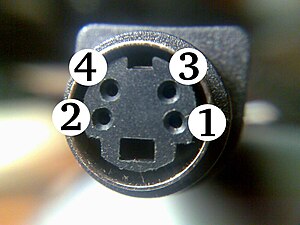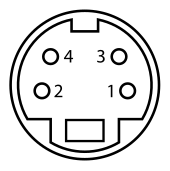S-video

A standard 4-pin S-Video cable connector, with each signal pin paired with its own ground pin
|
|||
| Type | Analog video connector | ||
|---|---|---|---|
| Designed | 1987 | ||
| Hot pluggable | Yes | ||
| External | Yes | ||
| Video signal | NTSC, PAL, or SECAM video | ||
| Pins | 4, 7, or 9 | ||
| Connector | Mini-DIN connector | ||
 |
|||
| Looking at the female connector | |||
| Pin 1 | GND | Ground (Y) | |
| Pin 2 | GND | Ground (C) | |
| Pin 3 | Y | Intensity (Luminance) | |
| Pin 4 | C | Color (Chrominance) | |
| The shells should be connected together by an overall screen/shield. However, the shield is often absent in low-end cables, which can result in picture degradation. | |||
S-Video (also known as separate video and Y/C) is a signaling standard for standard definition video, typically 480i or 576i. By separating the black-and-white and coloring signals, it achieves better image quality than composite video, but has lower color resolution than component video.
The S-video cable carries video using two synchronized signal and ground pairs, termed Y and C.
Y is the luma signal, which carries the luminance – or black-and-white – of the picture, including synchronization pulses.
C is the chroma signal, which carries the chrominance – or coloring-in – of the picture. This signal contains both the saturation and the hue of the video.
The luminance signal carries horizontal and vertical sync pulses in the same way as a composite video signal. Luma is a signal carrying luminance after gamma correction, and is therefore termed "Y" because of the similarity to the lower-case Greek letter gamma.
In composite video, the signals co-exist on different frequencies. To achieve this, the luminance signal must be low-pass filtered, dulling the image. As S-Video maintains the two as separate signals, such detrimental low-pass filtering for luminance is unnecessary, although the chrominance signal still has limited bandwidth relative to component video.
Compared with component video, which carries the identical luminance signal but separates the color-difference signals into Cb/Pb and Cr/Pr, the color resolution of S-Video is limited by the modulation on a subcarrier frequency of 3.57 to 4.43 megahertz, depending on the standard. It is worth noting that this difference is meaningless on home videotape systems, as the chrominance is already severely constrained by both VHS and Betamax.
Carrying the color information as one signal means that the color has to be encoded in some way, typically in accord with NTSC, PAL, or SECAM, depending on the applicable local standard.
Also, S-Video suffers from low color resolution. NTSC S-Video color resolution is typically 120 lines horizontal (approximately 160 pixels edge-to-edge), versus 250 lines horizontal for the Rec. 601-encoded signal of a DVD, or 30 lines horizontal for standard VCRs.
...
Wikipedia
